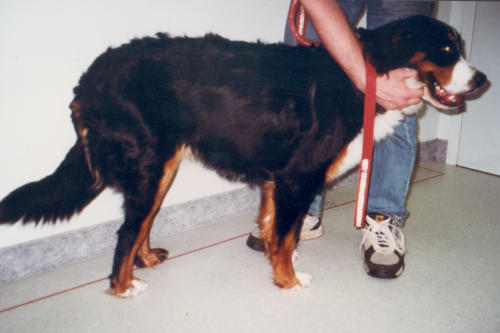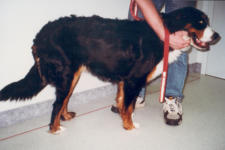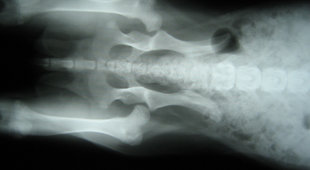
© Copyright Goldendoodles.com 2001. All rights reserved. You may not copy or otherwise use anything on this site without our written permission.
Made with Xara
Hip Dysplasia
Hip Dysplasia by Dr. Marlene Smith and Dr. Radica Raj Hip dysplasia is the medical term for poor hip conformation and the arthritis and pain that occurs secondary to that conformation. Normally the “ball” portion of the hip (the head of the femur) sits well within the “socket” portion of the pelvis. When the animal walks this acts as a well-oiled machine. In an animal with hip dysplasia either the “ball” portion does not sit within the hip socket but rather rests on the edge of the hip socket or the socket itself it too shallow to hold the hip in place. Instead of that nice smooth gliding motion, bone-on-bone contact occurs and just like wheels in a cog that do not fit properly, heat (inflammation) is produced. The body deals with this heat or inflammation by producing extra little bits of bone around the joint (in attempts to stabilize it). This causes the joint surface to become uneven and rough, we call this arthritis. Over time the ball portion of the hip becomes more and more deformed which, of course causes more pain and more severe hip dysplasia. A simple X-ray will show both the conformation of the hips as well as any arthritis around the joint. How do we know the dog might have hip problems? Not every hind leg problem is necessarily hip dysplasia. Knee or lower back problems can also create signs similar to hip issues. Hip dysplasia is partly genetic, meaning the mother or father of the dog may have the same problems. Diet (high carbohydrate and high fat), over exercising especially in large breeds of dogs) or injury can contribute to hip incongruence. What are some of the symptoms of hip dysplasia? Bunny hopping, running with both hind legs together, short strides of the hind legs, problems jumping up, muscle atrophy on the hind legs, sore and slow getting up especially after exercise and very sensitive and protective over the rear end. In chronic cases, looseness or laxity of the joint can cause subluxations or dislocations of the hips. How is it diagnosed? A thorough veterinary exam which includes a chiropractic evaluation will help to locate the problem at the hips. Radiographs are essential to rule out any other problems and to assess the severity of the dysplastic hips. What are the treatment options available for hip dysplasia? Besides anti-inflammatories, Western medicine has unfortunately very little to offer for management of dogs with hip dysplasia when the owners cannot afford surgical intervention. Dislocation of the hips due to looseness of the joint is usually corrected surgically. In cases with minimal osteo-arthritis, the surgical correction offered is called a Triple Pelvic Osteotomy. This involves making three incisions over the side of the hip, groin and rump, rotating the pelvis and then using plates and screws to keep the rotated pelvis in position. This procedure is done for dogs with no arthritis or minimal arthritis. If signs of arthritis are present with dislocation of the hip or if the dislocation is chronic, then the hip is not placed back into the socket. Instead, total hip replacement or femoral head and neck excision (Femoral head Osteotomy) is performed. This surgery has better outcome in small to medium breeds of dogs and cats. Phoenix Rising Veterinary Care is at this time able to offer the following options to manage hip dysplasia: Acupuncture, gold bead implants with Dr. Marlene Smith and prolotherapy with Dr. Radica Raj. Lately Dr. Radica has begun to work with Platelet Rich Plasma (PRP). More information on this modality will be provided in the near future. Acupuncture and Hip dysplasia Very fine needles are inserted into acupuncture points around the hip and in some distal acupuncture points. This releases chemicals in the brain called endorphins which not only makes the dog feel good, relaxed and sleepy but also reduces the pain locally. There is increased local blood flow which in turn provides cells and substances needed for healing. This will then enable us to rehabilitate the shortened and reduced muscles through specific exercises and swimming. Acupuncture sessions are done as 4 treatments 1 week apart. This may be done in conjunction with Chinese herbs and/or a homeopathic formula as indicated for the specific patient. After 4 treatments, we re-assess the dog for pain relief and proper use of the legs. If the acupuncture treatment has been successful, we then consider placing gold beads in the appropriate acupuncture points for long-term relief. These tiny beads will stimulate the acupuncture points for the rest of the dog’s life. In unstable hips (or knees) we might prefer to approach the problem by using prolotherapy. Prolotherapy is the injection of sterile solutions of dextrose with lidocaine (a local anaesthetic) into the joint and in the ligaments associated with the joint. This creates a small amount of inflammation in the joint that increases blood flow and therefore brings in cells needed for repair and healing. It also helps to tighten the ligament and therefore prevents the bone from slipping out of the socket. Thus, healing of the cartilage and bones at the joint is facilitated and further wear and tear is prevented. Details of prolotherapy treatment can be found on our website - www.phoenixrisingveterinarycare.com. Typical stance for a dog with hip dysplasia .



Goldendoodles.com


The information contained on this site is in no way intended to replace that of proper veterinary advice, diagnosis or treatment.
It is meant to provide resource, so that we can better understand canine health related issues.

© Copyright Goldendoodles.com 2001. All rights reserved. You may not
copy or otherwise use anything on this site without our written permission
Hip Dysplasia
Hip Dysplasia by Dr. Marlene Smith and Dr. Radica Raj Hip dysplasia is the medical term for poor hip conformation and the arthritis and pain that occurs secondary to that conformation. Normally the “ball” portion of the hip (the head of the femur) sits well within the “socket” portion of the pelvis. When the animal walks this acts as a well-oiled machine. In an animal with hip dysplasia either the “ball” portion does not sit within the hip socket but rather rests on the edge of the hip socket or the socket itself it too shallow to hold the hip in place. Instead of that nice smooth gliding motion, bone-on-bone contact occurs and just like wheels in a cog that do not fit properly, heat (inflammation) is produced. The body deals with this heat or inflammation by producing extra little bits of bone around the joint (in attempts to stabilize it). This causes the joint surface to become uneven and rough, we call this arthritis. Over time the ball portion of the hip becomes more and more deformed which, of course causes more pain and more severe hip dysplasia. A simple X-ray will show both the conformation of the hips as well as any arthritis around the joint. How do we know the dog might have hip problems? Not every hind leg problem is necessarily hip dysplasia. Knee or lower back problems can also create signs similar to hip issues. Hip dysplasia is partly genetic, meaning the mother or father of the dog may have the same problems. Diet (high carbohydrate and high fat), over exercising especially in large breeds of dogs) or injury can contribute to hip incongruence. What are some of the symptoms of hip dysplasia? Bunny hopping, running with both hind legs together, short strides of the hind legs, problems jumping up, muscle atrophy on the hind legs, sore and slow getting up especially after exercise and very sensitive and protective over the rear end. In chronic cases, looseness or laxity of the joint can cause subluxations or dislocations of the hips. How is it diagnosed? A thorough veterinary exam which includes a chiropractic evaluation will help to locate the problem at the hips. Radiographs are essential to rule out any other problems and to assess the severity of the dysplastic hips. What are the treatment options available for hip dysplasia? Besides anti-inflammatories, Western medicine has unfortunately very little to offer for management of dogs with hip dysplasia when the owners cannot afford surgical intervention. Dislocation of the hips due to looseness of the joint is usually corrected surgically. In cases with minimal osteo-arthritis, the surgical correction offered is called a Triple Pelvic Osteotomy. This involves making three incisions over the side of the hip, groin and rump, rotating the pelvis and then using plates and screws to keep the rotated pelvis in position. This procedure is done for dogs with no arthritis or minimal arthritis. If signs of arthritis are present with dislocation of the hip or if the dislocation is chronic, then the hip is not placed back into the socket. Instead, total hip replacement or femoral head and neck excision (Femoral head Osteotomy) is performed. This surgery has better outcome in small to medium breeds of dogs and cats. Phoenix Rising Veterinary Care is at this time able to offer the following options to manage hip dysplasia: Acupuncture, gold bead implants with Dr. Marlene Smith and prolotherapy with Dr. Radica Raj. Lately Dr. Radica has begun to work with Platelet Rich Plasma (PRP). More information on this modality will be provided in the near future. Acupuncture and Hip dysplasia Very fine needles are inserted into acupuncture points around the hip and in some distal acupuncture points. This releases chemicals in the brain called endorphins which not only makes the dog feel good, relaxed and sleepy but also reduces the pain locally. There is increased local blood flow which in turn provides cells and substances needed for healing. This will then enable us to rehabilitate the shortened and reduced muscles through specific exercises and swimming. Acupuncture sessions are done as 4 treatments 1 week apart. This may be done in conjunction with Chinese herbs and/or a homeopathic formula as indicated for the specific patient. After 4 treatments, we re-assess the dog for pain relief and proper use of the legs. If the acupuncture treatment has been successful, we then consider placing gold beads in the appropriate acupuncture points for long-term relief. These tiny beads will stimulate the acupuncture points for the rest of the dog’s life. In unstable hips (or knees) we might prefer to approach the problem by using prolotherapy. Prolotherapy is the injection of sterile solutions of dextrose with lidocaine (a local anaesthetic) into the joint and in the ligaments associated with the joint. This creates a small amount of inflammation in the joint that increases blood flow and therefore brings in cells needed for repair and healing. It also helps to tighten the ligament and therefore prevents the bone from slipping out of the socket. Thus, healing of the cartilage and bones at the joint is facilitated and further wear and tear is prevented. Details of prolotherapy treatment can be found on our website - www.phoenixrisingveterinarycare.com. Typical stance for a dog with hip dysplasia .FAQs


SECTION

The information contained on this site is in no way intended to
replace that of proper veterinary advice, diagnosis or treatment.
It is meant to provide resource, so that we can better understand
canine health related issues.













